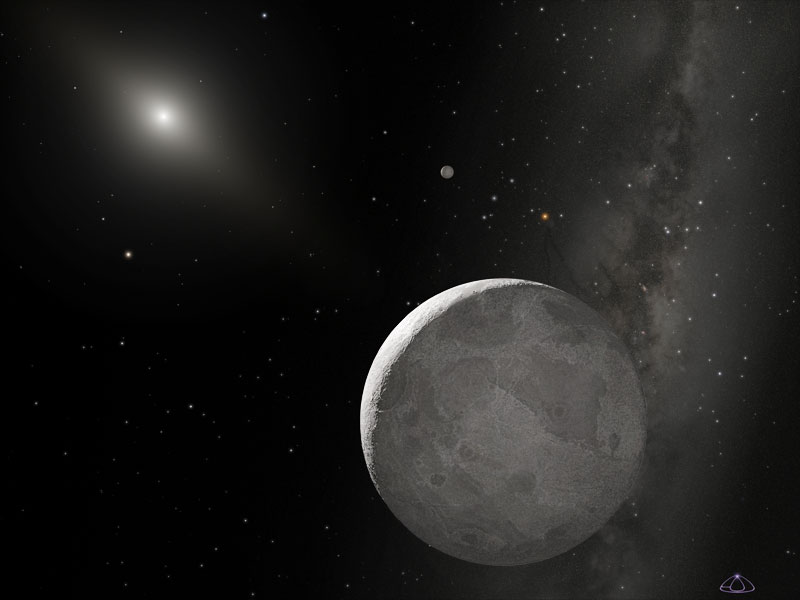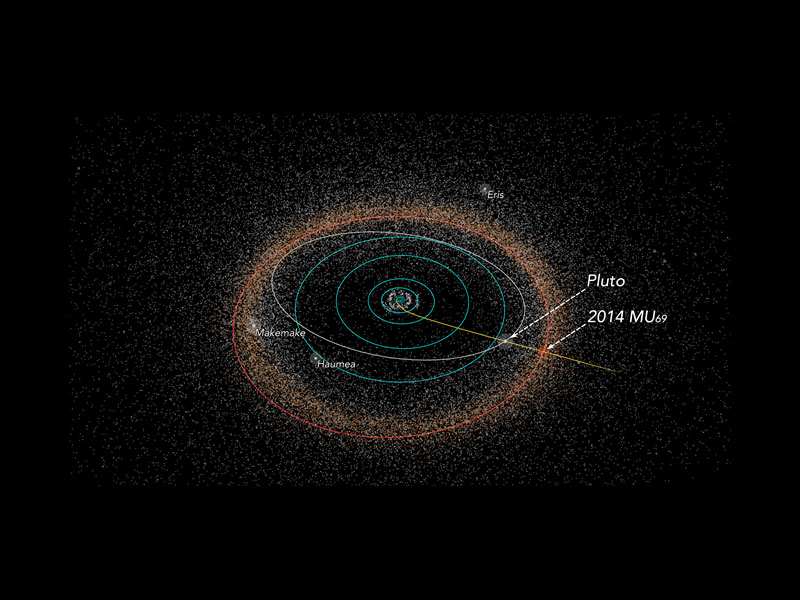The Eris/Dysnomia system I: The orbit of Dysnomia

- Ceres orbits in the asteroid belt between Mars and Jupiter. Makemake, like Pluto, is part of the Kuiper KI-per Belt, which is a region of trillions of icy objects orbiting beyond Neptune. Eris' orbit is even farther out. Astronomers have put these objects into a new family called dwarf planets.
- Calculate the scaled planet diameters and planet-sun distances for a solar system model. Enter scale or diameter or distance, select to show table and/or map below, select options, then press Calculate.
Abstract

We present new results on the Eris/Dysnomia system including analysis of new images from the WFC3 instrument on the Hubble Space Telescope (HST). Seven HST orbits were awarded to program 15171 in January and February 2018, with the intervals between observations selected to sample Dysnomia over a full orbital period. Using relative astrometry of Eris and Dysnomia, we computed a best-fit Keplerian orbit for Dysnomia. Based on the Keplerian fit, we find an orbital period of 15.785899±0.000050 days, which is in good agreement with recent work. We report a non-zero eccentricity of 0.0062 at the 6.2-σ level, despite an estimated eccentricity damping timescale of ≤17 Myr. Considering the volumes of both Eris and Dysnomia, the new system density was calculated to be 2.43±0.05 g cm-3, a decrease of ~4% from the previous value of 2.52±0.05 g cm-3. The new astrometric measurements were high enough precision to break the degeneracy of the orbit pole orientation, and indicate that Dysnomia orbits in a prograde manner. The obliquity of Dysnomia's orbit pole with respect to the plane of Eris' heliocentric orbit was calculated to be 78.29±0.65∘ and is in agreement with previous work; the next mutual events season will occur in 2239. The Keplerian orbit fit to all the data considered in this investigation can be excluded at the 6.3-σ level, but identifying the cause of the deviation was outside the scope of this work.
Eris was once considered for the position of tenth planet. Eris is the most massive dwarf planet in the Solar System, exceeding Pluto’s mass by 28%. As such, it was a serious contender to be a tenth planet but failed to meet the criteria set out by the International Astronomical Union in 2006. Eris was named after the Greek goddess of discord.

- Kuiper belt;
- Trans-neptunian objects;
- Hubble space telescope observations;
- Orbit determination;
- Astrophysics - Earth and Planetary Astrophysics
Discovery
Triton was discovered on Oct. 10, 1846 by British astronomer William Lassell, just 17 days after Neptune itself was discovered.
Overview
Triton is the largest of Neptune's 13 moons. It is unusual because it is the only large moon in our solar system that orbits in the opposite direction of its planet's rotation―a retrograde orbit.
Scientists think Triton is a Kuiper Belt Object captured by Neptune's gravity millions of years ago. It shares many similarities with Pluto, the best known world of the Kuiper Belt.
Like our own moon, Triton is locked in synchronous rotation with Neptune―one side faces the planet at all times. But because of its unusual orbital inclination both polar regions take turns facing the Sun.
Triton has a diameter of 1,680 miles (2,700 kilometers). Spacecraft images show the moon has a sparsely cratered surface with smooth volcanic plains, mounds and round pits formed by icy lava flows. Triton consists of a crust of frozen nitrogen over an icy mantle believed to cover a core of rock and metal. Triton has a density about twice that of water. This is a higher density than that measured for almost any other satellite of an outer planet. Europa and Io have higher densities. This implies that Triton contains more rock in its interior than the icy satellites of Saturn and Uranus.
Triton's thin atmosphere is composed mainly of nitrogen with small amounts of methane. This atmosphere most likely originates from Triton's volcanic activity, which is driven by seasonal heating by the Sun. Triton, Io and Venus are the only bodies in the solar system besides Earth that are known to be volcanically active at the present time.
Triton is one of the coolest objects in our solar system. It is so cold that most of Triton's nitrogen is condensed as frost, giving its surface an icy sheen that reflects 70 percent of the sunlight that hits it.
NASA's Voyager 2―the only spacecraft to fly past Neptune and Triton―found surface temperatures of -391degrees Fahrenheit (-235 degrees Celsius). During its 1989 flyby, Voyager 2 also found Triton has active geysers, making it one of the few geologically active moons in our solar system.
How Triton Got its Name

Triton is named after the son of Poseidon (the Greek god comparable to the Roman Neptune). Until the discovery of the second moon Nereid in 1949, Triton was commonly known as simply 'the satellite of Neptune.'
Eris And Sedna Orbit
